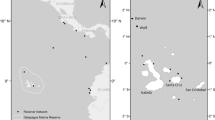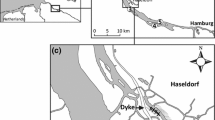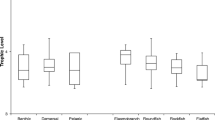Abstract
Recently, a highly invasive alien species, the zebra mussel Dreissena polymorpha, has colonized Italian aquatic ecosystems that had been previously colonized by another highly invasive alien species—the North American crayfish Procambarus clarkii. This was the first time and world region where these two species met. To evaluate the relative importance of their interactions, we studied prey selection according to its length, as well as prey choice by P. clarkii preying on D. polymorpha in the presence and absence of alternative prey—the freshwater snail Physella acuta. We followed an optimability-based approach, by first estimating the most profitable length of each mollusc and then by conducting a prey choice experiment, on which both species were provided simultaneously to a crayfish with different size combinations. Prey selection was dependent on prey length, handling time and crayfish length for both molluscs. According to our profitability estimates, snails should be more profitable than mussels in the length range 7–10 mm, while for lengths over 11.0 mm, mussels should be more profitable. The results of the prey choice experiment indicated that D. polymorpha length, P. acuta length, and the difference in profitability between the offered individuals were all relevant for the choice of one species over the other by P. clarkii. However, the overall tendency was the choice of the smallest prey, regardless of species, and the estimates of prey profitability were not useful to predict prey choice. Our study shows that D. polymorpha represents a novel prey resource for P. clarkii, even in the presence of an alternative prey, and that zebra mussels may be a preferred prey, especially small-sized individuals (5–10 mm).




Similar content being viewed by others
References
Alexander JE, Covish AP (1991) Predation risk and avoidance behaviour in two freshwater snails. Biol Bull 180:387–393
Annoni D, Bianchi I, Girod A, Mariani M (1978) Inserimento di Dreissena polymorpha (Pallas) (Mollusca Bivalvia) nelle malacocenosi costiere del Lago di Garda (Nord Italia). Quaderni della Civica Stazione Idrobiologica di Milano 6:5–84
Aquiloni L, Tricarico E, Gherardi F (2010) Crayfish in Italy: distribution, threats and management. Invited review Int Aquat Res 2:1–14
Baumgartner D, Rothhaupt K-O (2003) Predictive length-dry mass regressions for freshwater invertebrates in a pre-alpine lake littoral. Int Rev Hydrobiol 88(5):453–463
Botts PS, Patterson BA, Schloesser DW (1996) Zebra mussel effects on benthic invertebrates: physical or biotic? J N Am Benthol Soc 15:179–184
Brown KM, Haight ES (1992) The foraging ecology of the Gulf of Mexico stone crab Menippe adina (Williams et Felder). J Exp Mar Biol Ecol 160:67–80
Burgher PR, Meyer AEI (1997) Regression analysis of linear body dimensions vs. dry mass in stream macroinvertebrates. Arch Hydrobiol 139:l0l–112
Burnham KP, Anderson DR (2002) Model selection and multimodel inference: a practical information-theoric approach, Second edn. Springer-Verlag, New York
Carreira BM, Dias MP, Rebelo R (2014) How consumption and fragmentation of macrophytes by the invasive Procambarus clarkii shape the macrophyte communities of temporary ponds. Hydrobiologia 721:89–98
Casagrandi R, Mari L, Gatto M (2007) Modelling the local dynamics of the zebra mussel (Dreissena polymorpha). Freshw Biol 52:1223–1238
Charnov EL (1976) Optimal foraging: attack strategy of a mantid. Am Nat 110:141–151
Chilton NB, Bull CL (1986) Size-related selection of 2 intertidal gastropods by the reef crab Ozius truncatus. Mar Biol 93:475–480
Claussen DL, Gerald GW, Kotcher JE, Miskell CA (2008) Pinching forces in crayfish and fiddler crabs, and comparisons with the closing forces of other animals. J Comp Physiol B 178(3):333–342
Covich AP, Dye LL, Mattice JS (1980) Crayfish predation on Corbicula under laboratory conditions. Am Midl Nat 105:181–188
Creswell PD, McLay CL (1990) Handling times, prey size and species selection by Cancer novaezelandidae (Jacquinot, 1853) feeding on molluscan prey. J Exp Mar Biol Ecol 140:13–28
Cruz MJ, Pascoal S, Tejedo M, Rebelo R (2006) Predation by an exotic crayfish, Procambarus clarkii, on Natterjack, Bufo calamita, embryos: its role on the exclusion of this amphibian from its breeding ponds. Copeia 2006(2):274–280
Dana ED, Ortega F (2010) The advance of Procambarus clarkii into Austropotamobius pallipes populations can be contained by small dams. Management of Biological Invasions 1(1):5–8
Davidson RJ (1986) Mussel selection by the paddle crab Ovalipes catharus: evidence of flexible foraging behaviour. J Exp Mar Biol Ecol 102:28l–299
Dickey BF, McCarthy TM (2007) Predator–prey interactions between crayfish (Orconectes juvenilis) and snails (Physa gyrina) are affected by spatial scale and chemical cues. Invertebrate Biol 126:57–66
Draparnaud J-PR (1805) Histoire naturelle des mollusques terrestres et fluviatiles de la France. Ouvrage posthume. Avec XIII planches. (Plassan, Renaud). Montpellier, Paris, pp. 1–9, j-viij [= 1–8], 1–134, [Plates 1–13]
Dudas SE, McGaw IJ, Dower JF (2005) Selective crab predation on native an introduced bivalves in British Columbia. J Exp Mar Biol Ecol 325:8–17
Ebersole EL, Kennedy VS (1995) Prey preferences of blue crabs Callinectes sapidus feeding on three bivalve species. Mar Ecol Prog Ser 118:167–177
Eggleston DB (1990) Behavioural mechanisms underlying variable functional responses of blue crabs, Callinectes sapidus feeding on juvenile oysters, Crassostrea virginica. J Anim Ecol 59:615–630
Elner RW, Hughes RN (1978) Energy maximization in the diet of the shore crab Carcinus maenas. J Anim Ecol 47:103–116
Ermgassen PSE, Aldridge DC (2011) Predation by the invasive American signal crayfish, Pacifastacus leniusculus Dana, on the invasive zebra mussel, Dreissena polymorpha Pallas: the potential for control and facilitation. Hydrobiologia 658:303–315
Fryxell JM, Lundberg P (1994) Diet choice and predator—prey dynamics. Evol Ecol 8:407–421
Gherardi F (2007a) Biological invasions in inland waters: an overview. In: Gherardi F (ed) Biological invaders in inland waters: profiles, distribution, and threats. Springer, Dordrecht, pp 3–25
Gherardi F (2007b) Understanding the impact of invasive crayfish. In: Gherardi F (ed) Biological invaders in inland waters: profiles, distribution, and threats. Springer, Dordrecht, pp 507–542
Gherardi F, Barbaresi S (2007) Feeding preferences of the invasive crayfish Procambarus clarkii. Bull Fr Pêche Piscic 385:7–20
Gherardi F, Holdich DM (Editors) (1999) Crayfish in Europe as alien species. How to make the best of a bad situation? A A Balkema, Rotterdam
Girard C (1852) A revision of the North American astaci, with observations on their habitats and geographic distribution. P Acad Nat Sci Phila 6:87–91
Gonçalves V, Gherardi F, Rebelo R (2016) Modelling the predation effects of invasive crayfish, Procambarus clarkii (Girard, 1852), on invasive zebra mussel, Dreissena polymorpha (Pallas, 1771), under laboratory conditions . Ital J Zool 83(1):59–67
Gutiérrez-Yurrita PJ (1997) El papel ecológico del cangrejo rojo de la marisma Procambarus clarkii (Crustacea: Decapoda: Cambaridae), en el Parque National de Doñana. Una perspectiva bioenergética con implicationes en la gestión. PhD thesis, Facultad de Ciencias Universidad Autónoma de Madrid, Madrid, Spain.
Gutiérrez-Yurrita PJ, Sancho G, Bravo MÀ, Baltanás Á, Montes C (1998) Diet of the red swamp crayfish Procambarus clarkii in natural ecosystems of the Doñana National Park temporary fresh-water marsh (Spain). J Crustac Biol 18:120–127
Hamilton PV (1976) Predation of Littorina inorata (Mollusca: Gastropoda) by Callinectes sapidus (Crustacea: Portunidae). Bull Marine Science 26:403–409
Hobbs HH, Jass JP, Huner JV (1989) A review of global crayfish introductions with particular emphasis on two North American species (Decapoda, Cambaridae). Crustaceana 56:299–316
Hughes RN (1997) Diet selection. In: Godin J-GJ (ed) Behavioural ecology of teleost fishes. Oxford University Press, Oxford, pp 134–162
Hughes RN, Seed R (1981) Size selection of mussels by the blue crab Callinectes sapidus: energy maximizer or time minimizer? Mar Ecol Prog Ser 6:83–89
Hughes RN, Seed R (1995) Behavioural mechanisms of prey selection in crabs. J Exp Mar Biol Ecol 193:225–238
Huner JV (2002) Procambarus. In: Holdich DM (ed) Biology of freshwater crayfish. Blackwell Scientific Press, Oxford, pp 541–574
Ilhéu M, Bernardo JM (1993a) Aspects of trophic ecology of red swamp crayfish (Procambarus clarkii Girard) in Alentejo, South of Portugal. Actas VI Congreso Español de Limnologia, Granada, Spain
Ilhéu M, Bernardo JM (1993b) Experimental evaluation of food preference of red swamp crayfish, Procambarus clarkii: vegetal versus animal. Freshwater Crayfish 9:359–336
Jackson AC, Underwood AJ (2007) Application of new techniques for the accurate analysis of choice of prey. J Exp Mar Biol Ecol 341:1–9
Juanes F (1992) Why do decapod crustaceans prefer small sized molluscan prey? Mar Ecol Prog Ser 87:239–249
Karatayev AY, Burlakova, LE, Padilla DK (2002) Impacts of zebra mussels on aquatic communities and their role as ecosystem engineers. In: Leppäkoski E, Gollasch S, Olenin S (ed) Invasive aquatic species of Europe: Distributions, Impacts and Management, Dordrecht Kluwer Scientific Publishers, pp 433–446
Keller RP, zu Ermgassen PSE, Aldridge DC (2009) Vectors and timing of freshwater invasions in Great Britain. Conserv Biol 23: 1526–1534
Klocker C, Strayer DL (2004) Interactions among an invasive crayfish (Orconectes rusticus), a native crayfish (Orconectes limosus) and native bivalves (Sphaeriidae and Unionidae). Northeast Nat 11:167–178
Lancioni T, Gaino E (2006) The invasive zebra mussel Dreissena polymorpha in Lake Trasimeno (Central Italy): distribution and reproduction. Italian Journal of Zoology 73(4):335–346
Lawton P, Hughes RN (1985) Foraging behaviour ofthe crab Cancer pagurus feeding on the gastropods Nucella lapillus and Littorina littorea, comparisons with optimal foraging theory. Mar Ecol Prog Ser 27:143–154
Lodge DM, Shrader-Frechette K (2003) Nonindigenous species: ecological explanation, environmental ethics, and public policy. Conserv Biol 17:31–37
Love J, Savino J (1993) Crayfish (Orconectes virilis) predation on zebra mussels (Dreissena polymorpha). J Freshw Ecol 8:253–259
Lori E, Cianfanelli S (2006) New records of Dreissena polymorpha (Pallas, 1771) (Mollusca: Bivalvia: Dreissenidae) from Central Italy. Aqua Invasions 4(1):281–283
MacArthur RH, Pianka ER (1966) On the optimal use of a patchy environment. Am Nat 100:603–609
MacIsaac HJ (1994) Size-selective predation on zebra mussels (Dreissena polymorpha) by crayfish (Orconectes propinquus). J N Am Benthol Soc 13:206–216
MacIsaac HJ (1996) Potential abiotic and biotic impacts of zebra mussels on the inland waters of North America. Am Zool 36:287–299
Magoulick DD, Lewis LC (2002) Predation on exotic zebra mussels by native fishes: effects on predator and prey. Freshw Biol 47:1908–1918
Martin GW, Corkum LD (1994) Predation of zebra mussels by crayfish. Can J Zool 72:1867–1871
Mascaró LM, Seed R (2000) Foraging behavior of Carcinus maenas (L.): comparisons of size-selective predation on four species of bivalve prey. J Shellfish Res 19:283–291
Mascaró LM, Seed R (2001) Choice of prey size and species in Carcinus maenas (L.) feeding on four bivalves of contrasting shell morphology. Hydrobiologia 449:159–170
Mistri M (2004) Predatory behavior and preference of a successful invader, the mud crab Dyspanopeus sayi (Panopeidae), on its bivalve prey. J Exp Mar Biol Ecol 312:385–398
Montes C, Bravo-Utrera M Á, Baltanás Á, Duarte C., J.P. Gutiérrez-Yurrita (1993) Bases ecológicas para la gestión integral del cangrejo rojo de las marismas del Parque Nacional de Doñana. ICONA, Madrid
Naddafi R, Rudstam LG (2014) Predator-induced morphological defences in two invasive dreissenid mussels: implications for species replacement. Freshw Biol 59(4):703–713
Nagarajan R, Lea SGE, Goss-Custard JD (2006) Seasonal variations in mussel, Mytilus edulis L. shell thickness and strength and their ecological implications. J Exp Mar Biol Ecol 339(2):241–250.
Nyström P (2002) Ecology. In: Holdich DA (ed) Biology of freshwater crayfish. Blackwell Science, Oxford, pp 192–235
Nyström P, Pérez JR (1998) Crayfish predation on the common pond snail (Lymnaea stagnalis): the effect of habitat complexity and snail size on faraging efficiency. Hydrobiologia 368:201–208
Osenberg CW, Mitterbach GG (1989) Effects of body size on the predator-prey interaction between pumpkinseed sunfish and gastropods. Ecol Monogr 59(4):405–432
Pallas PS (1771) Reise durch verschiedene Provinzen des Russischen Reichs. Theil 1. Physicalische Reise durch verschiedene Provinzen des Russischen Reichs im 1768 und 1769 sten Jahren. Kayserliche Akademie der Wissenschaften, St. Petersburg
Perry WL, Lodge DM, Lamberti GA (1997) Impact of crayfish predation on exotic zebra mussels and native invertebrates in a lake-outlet stream. Can J Fish Aquat Sci 54:120–125
Perry WL, Lodge DM, Lamberti GA (2000) Crayfish (Orconectes rusticus) impacts on zebra mussel (Dreissena polymorpha) recruitment, other macroinvertebrates and algal biomass in a lake-outlet stream. Am Midl Nat 144:308–316
Piesik Z (1974) The role of the crayfish Orconectes limosus (Raf.) in extinction of Dreissena polymorpha (Pall.) subsisting on steelon-net. Polskie Archiwum Hydrobiologh 21(3/4):401–410
Prejs A, Lewandowski K, Stanczykowska-Piotrowska A (1990) Size-selective predation by roach (Rutilus rutilus) on zebra mussel (Dreissena polymorpha): field studies. Oecologia 83:378–384
Rajarathinavelu Nagarajan, Stephen E.G. Lea, John D. Goss-Custard, (2015) Do oystercatchers (Haematopus ostralegus) select the most profitable limpets (Patella spp.)?. Journal of Experimental Marine Biology and Ecology 464:26–34
Renai B, Gherardi F (2004) Predatory efficiency of crayfish: comparison between indigenous and non-indigenous species. Biol Invasions 6:89–99
Reynolds JD, Donohoe R (2001) Crayfish predation experiments on the introduced zebra mussel, Dreissena polymorpha, in Ireland, and their potential for biocontrol. Bull Fr Pêche Piscic 361:669–681
Rovero F, Hughes RN, Chelazzi G (2000) When time is of the essence: choosing a currency for prey-handling costs. J Appl Anim Ecol 69:683–689
Sala OE, Chapin FS III, Armesto JJ, Berlow R, Bloomfield J, Dirzo R, Huber-Sanwald E, Huenneke LF, Jackson RB, Kinzig A, Leemans R, Lodge D, Mooney HA, Oesterheld M, Poff NL, Sykes MT, Walker BH, Walker M, Wall DH (2000) Global biodiversity scenarios for the year 2100. Science 287:1770–1774
Sanchez-Salazar ME, Griffiths CL, Seed R (1987) The effect of size and temperature on the predation of cockles Cerastoderma edule (L.) by the shore crab Carcinus maenas (L.). J Exp Mar Biol Ecol 111:181–193
Schreiber S, Odelstrom T, Pettersson K, Eichelberg D (1998) The zebra mussel Dreissena polymorpha as a food source for the signal crayfish Pacifastacus leniusculus in Lake Erken—laboratory experiments. Ergebnisse der Limnologie 51:169–176
Smallegange IM, Van der Meer J (2003) Why do shore crabs not prefer the most profitable mussels? J Anim Ecol 72(4):599–607
Stein RA, Goodman CG, Marschall EA (1984) Using time and energetic measures of costs in estimating prey value for fish predators. Ecology 65(3):702–715
Strayer DL (2010) Alien species in fresh waters: ecological effects, interactions with other stressors, and prospects for the future. Freshw Biol 55(1):152–174
Souty-Grosset C, Holdich DM, Noel PY, Reynolds JD, Haffner P (eds) (2006) Atlas of Crayfish in Europe. Museum National d’ Histoire Naturelle (Patrimoines Naturels 64), Paris
Toomey MB, Mccabe D, Marsden JE (2002) Factors affecting the movement of adult zebra mussels (Dreissena polymorpha). J N Am Benthol Soc 21:468–475
Underwood AJ, Clarke KR (2005) Solving some statistical problems in analyses of experiments on choices of food and on associations with habitat. J Exp Mar Biol Ecol 318(2):227–237
Van der Velde G, Rajagopal GS, Kelleher B, Musko IB, Bij de Vaate A (2000) Ecological impact of crustacean invaders: general considerations and examples from the Rhine River. Crustacean Issues 12:3–33
Acknowledgements
We thank Laura Aquiloni, Alberto F. Inghilesi, Giuseppe Mazza, Gabriele Orioli, Daniele Spigoli, Elena Tricarico and Filipe Barroso for assistance with field collections. Carolina Laurentino for help with mathematical questions. Vera Gonçalves participation in the PhD program at the University of Florence was funded by the “Fundação para a Ciência e a Tecnologia” (FCT-Portugal)-SFRH/BD/43963/2008.
Author information
Authors and Affiliations
Corresponding author
Rights and permissions
About this article
Cite this article
Gonçalves, V., Gherardi, F. & Rebelo, R. Bivalve or gastropod? Using profitability estimates to predict prey choice by P. clarkii . acta ethol 20, 107–117 (2017). https://doi.org/10.1007/s10211-017-0251-x
Received:
Revised:
Accepted:
Published:
Issue Date:
DOI: https://doi.org/10.1007/s10211-017-0251-x




